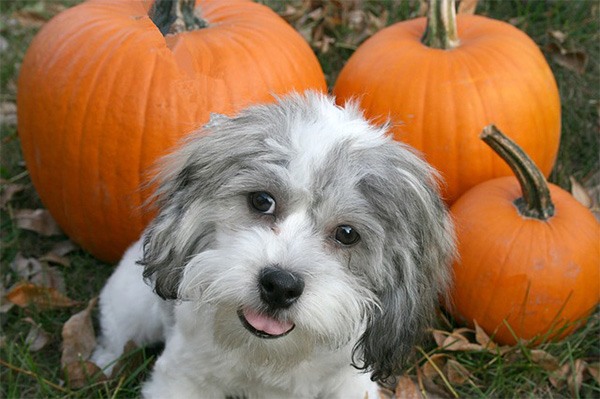Halloween may be about scary ghosts and goblins, but it can be a lot of fun for us humans. Whether children or adults, we get to dress up as our favorite alter egos for one special night of the year. Plus, who doesn’t love a little candy?

Halloween for our pets, though, can be a different story. The holiday can be a scary night for our furry friends that do not understand what’s happening around them. They may be thinking to themselves, “Why do I smell humans, but see unrecognizable faces? Where can I chomp my teeth into all those delicious candies I’m smelling? Why are all these lawns filled with creatures that look like they could attack me or my human? What is this annoying piece of clothing on me?” As a result, HalloweenPulse.com recently compiled a list of simple tips from PetMD and ASPCA to follow this Halloween season. These Halloween safety tips for pets will help keep your pet safe, secure, and happy.
Halloween Safety Tips for Pets
Stash the Sweets
The trick-or-treat candy is for humans only. All types of chocolate can be harmful, even toxic, to cats and dogs. It may not be as well-known that sugar-free candies that contain artificial sweetener xylitol can also cause harmful to pets. As a result, it’s important to make sure that the candy bowl is in a place that your pet cannot reach it. Cats and dogs can be especially sneaky when it comes to smelling something that they want to get their paws on, so keep in mind that simply putting the candy bowl on a counter may not be enough to keep them away.
The ASPCA recommends to immediately call your veterinarian or the ASPCA Poison Control Center at (888) 426-4435 if it’s suspected that your pet may have eaten something toxic. PetMD has a handy Dog Chocolate Toxicity Meter that can be helpful to reference.
Just because your pet cannot have human treats does not mean that they cannot have Halloween fun with dog or cat treats, though. Many pet stores now carry Halloween themed dog treats, and there are also plenty of DIY recipes to find only.
Keep Halloween Plants Out Of Reach
Halloween plants, such as pumpkins, gourds, and corn, although relatively nontoxic, can induce gastrointestinal upset if ingested by pets. PetMD notes that this is usually only if ingested in large quantities, or that intestinal blockage may occur if large pieces are swallowed. As always, it’s better to be safe than sorry, though.
Lighted pumpkins and jack-o-lanterns are also an important potential Halloween threat to keep in mind with your pet. Pets can easily knock over a lit pumpkin and start a fire. The ASPCA explained that curious kittens are especially at risk of getting burned or singed by candle flame.
Be Aware of Decorations and Wires
Much like lighted pumpkins and jack-o-lanterns, pets may become curious, or interested in chewing on, various Halloween decorations. Be especially mindful of decorations that include glass and plastic, as well as wires. If a dog or cat chews on a wire, they may be at risk of an electrical shock.
Keep Pets in Safe Areas for Halloween
Halloween Pulse and PetMD broke down three actions to take on and around Halloween time:
- Don’t leave pets in yards on Halloween
- Keep pets away from the door on Halloween
- Keep outdoor cats inside several days before and several days after Halloween
PetMD explain that, while it’s difficult to believe, pranksters come out around Halloween time that, “have been known to tease, injure, steal, and even kill pets on Halloween night.” While this is inexcusable, PetMD notes that it’s preventable my keeping your furry friends in safe areas inside the house.
Like mentioned earlier, Halloween can be a scary time for pets, not knowing why familiar surroundings and people have changed, and leading to anxiety. With trick-or-treaters constantly ringing the doorbell all night long and showing up in creepy costumes, it can be helpful to keep your furry friend away from the door. This way, there is no chance of them possibly darting out the door out of anxiousness.
Be Mindful of Pet Halloween Costumes
Some pets love their Halloween costumes, while others hate them. Wearing a costume can even cause stress in some pets. The ASPCA recommends not to put your cat or dog in a Halloween costume unless you’ll know they’ll love it. Start early with discovering if your pet is okay with their Halloween costume. This means, don’t expect to just put the costume on the day of the Halloween parade, or on Halloween. Let them get acquainted with the costume several days, or even weeks, before the big parade, party or Trick-or-treat night. You can check out our 20+ Best Pet Halloween Costumes to get searching sooner, rather than later.
There are also important factors to take into consideration if you do dress your pet up for Halloween. PetMD explains to make sure, “the costume does not limit his or her movement, sight or ability to breathe, bark or meow.” It’s also important to check the costume for small, dangling or easily chewed-off pieces that may prevent a choking hazard. The costume should fit your pet well to help avoid these issues.
Of course, there are always festive Halloween bandanas that your furry friend can rock instead! These may be safer, and most pets are okay with wearing them.
Pets Should Be Wearing IDs
Ensure your pets are easily identifiable by having their collars with ID tags on. This way, if a worst case scenario does happen, surrounding humans can help him or her safely find their way back home.
All of these pet safety tips aren’t meant to scare you on Halloween night. Just remember to be aware of your and your pet’s surroundings, and have a scary good time!
